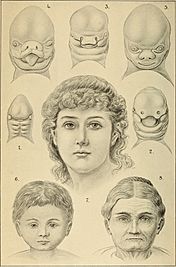Face facts for kids
The face is the front part of your head. It's how people recognize you and how you show your feelings. Your face holds important sense organs like your eyes for seeing, nose for smelling, and mouth for tasting and speaking.
For humans, the face includes your hairline, forehead, eyebrows, eyelashes, eyes, nose, ears, cheeks, mouth, lips, teeth, skin, and chin. It's a very important part of how we interact with the world!
Contents
What Makes Up Your Face?
Your face has many different parts that work together. Here are the main features:
- The forehead: This is the area of skin below your hairline, between your temples and above your eyebrows.
- Your eyes: They sit in bony hollows called orbits and are protected by eyelids and eyelashes.
- Your human nose: It has a unique shape, nostrils, and a middle wall called the nasal septum.
- Your cheeks: These cover the bones of your upper jaw (maxilla) and lower jaw (mandible). The lowest part of your jaw is your chin.
- Your mouth: Your upper lip has a small groove called the philtrum. Sometimes, your teeth can be seen when you talk or smile.
Your face is super important for recognizing people and for communication. The Facial muscles in your face let you make many different expressions to show how you feel.
The face is also a very sensitive area. Its expression can change when your brain reacts to things you feel. This includes touch, temperature, smell, taste, hearing, movement, hunger, or things you see.
How Your Face Gets Its Shape
Your face is what makes you unique! Special parts of your brain, like the fusiform face area, help you recognize faces. If this area is damaged, it can be hard to recognize even close family members. The unique pattern of your eyes, nose, and mouth is used in biometric identification to tell people apart.
The shape of your face comes from the bones in your skull. Everyone's face is different because of small changes in these bones. The main bones that shape your face are the maxilla (upper jaw), mandible (lower jaw), nasal bone (nose), and zygomatic bone (cheekbones). Soft tissues like fat, hair, and skin also play a big part in your face's look.
Your face changes as you grow. For example, children and babies have fuller cheeks because of fat-pads. These fat-pads help babies when they are suckling. As you get older, these fat-pads often get smaller, and your bones become more noticeable.
The shape of your face, especially if it's symmetrical, is often seen as a part of beauty.
What Your Face Does
Showing Emotions
Faces are super important for showing how you feel, whether you mean to or not. A frown usually means someone is unhappy, while a smile often means they are pleased. Being able to understand emotions from someone's face is a basic skill that helps us feel empathy. It also helps us understand how a person might react.
The muscles in your face are very important for showing emotions. These muscles can be different from person to person, which adds to the many ways we can express ourselves.
People are also pretty good at telling if a smile is real or fake. One study found that older adults were better than younger adults at telling the difference between a forced smile and a real one. This suggests that with more life experience, we get better at seeing true emotions on faces.
How We See and Recognize Faces

Some scientists, called Gestalt psychologists, believe that a face is more than just a collection of features. They think we see a face as a whole, meaningful picture, not just separate parts. This idea fits with the Gestalt theory that we understand images in their entirety. According to researcher Gary L. Allen, humans learned to react strongly to faces over time because we are social creatures. He suggests that recognizing faces helps parents and babies connect quickly. This reduces the chance that a parent might not recognize their child.
The Brain's Role in Face Recognition
Research shows that certain parts of the brain are especially good at recognizing faces. The fusiform face area (FFA), located in the fusiform gyrus, becomes active when you see faces. This area even reacts differently in shy people compared to social people. One study found that shy adults had less activity in their fusiform gyri when looking at pictures of strangers.
Also, some brain areas react more to faces that are considered attractive. One study showed that "facial beauty activates a wide network in the brain, involving areas for seeing, making decisions, and feeling rewarded." This means that even if you're not trying to judge beauty, your brain still reacts to it.
See also
 In Spanish: Cara para niños
In Spanish: Cara para niños









